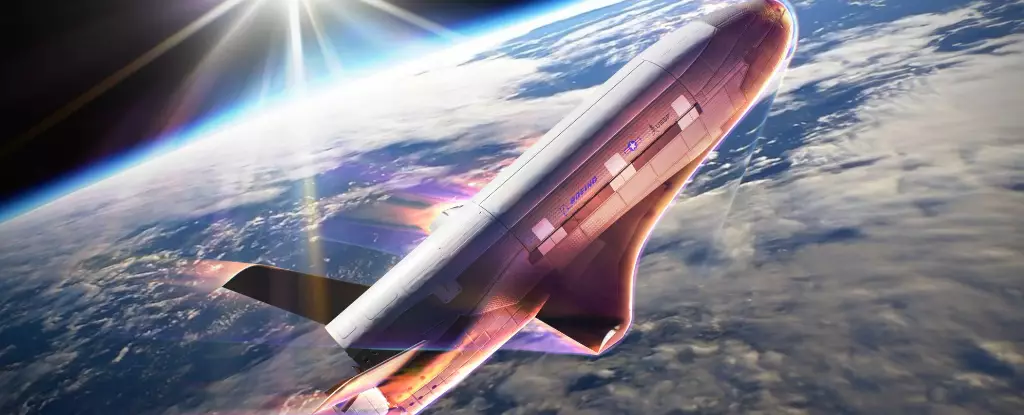The X-37B Orbital Test Vehicle (OTV), a product of Boeing’s ingenuity and the US Space Force (USSF)’s strategic vision, has captivated the attention of space enthusiasts and cybersecurity experts alike since its inaugural flight in 2011. This remotely operated, reusable space plane is designed specifically for Low-Earth Orbit (LEO) operations—ranging from 240 to 800 kilometers (150 to 500 miles) above our planet. As it embarks on its seventh mission, the enigmatic nature of the X-37B raises questions and curiosity regarding its true capabilities and objectives.
The X-37B commenced its seventh mission (OTV-7) on December 29, 2023. This mission aims to explore a series of intriguing experiments, including studies on space radiation’s impact and advancements in Space Domain Awareness (SDA) technologies. Notably, this mission will see the spacecraft executing a first-of-its-kind series of procedures: employing aerobraking maneuvers. This technique allows the X-37B to interact with the Earth’s upper atmosphere, effectively shedding speed and lowering its orbit while conserving fuel—an impressive feat that underscores the vehicle’s sophisticated engineering.
Aerobraking is a method that has gained recognition for its effectiveness in space exploration, particularly through its application in other successful missions to celestial bodies like Mars. The technique is not merely an innovative idea; it represents a culmination of decades of research and operational lessons learned from historical missions. The introduction of aerobraking into the X-37B’s repertoire marks an important milestone for the USSF, enhancing the vehicle’s ability to remain undetected while navigating complex orbital trajectories.
The strategic implications of the X-37B’s maneuvers are profound. The ability to perform delicate aerodynamic adjustments offers significant advantages in evading detection from potential adversaries, enabling surveillance and other covert operations without prior notice. As Secretary of the Air Force Frank Kendall stated, this series of maneuvers represents the USSF’s commitment to innovative space technologies that enhance national security operations.
Adding to the strategic conversation, former U.S. Air Force Secretary Heather Wilson described the unique orbital capabilities of the X-37B. The vehicle’s ability to take on an elliptical orbit allows it to remain unpredictable, complicating tracking efforts by foreign observers. This unpredictability is both a tactical advantage and a psychological weapon, as it generates uncertainty and speculation among rival nations, something U.S. operatives presumably leverage to their benefit.
Jonathan McDowell, an astronomer and astrophysicist, highlighted how such orbital capabilities can lead to significant disruptions in enemy prediction algorithms, thereby creating additional challenges for adversaries to track the spacecraft accurately. The combination of advanced maneuverability and stealth represents not only an engineering marvel but also a potential game-changer in the realm of international relations and defense.
Once the aerobraking maneuvers are completed, the X-37B will pivot back to its core mission—conducting tests designed to push the boundaries of space technology. The focus is especially on experimenting with novel SDA technologies and assessing radiation impacts on plant seeds through the “Seeds-2” experiment, which examines how space radiation affects biological growth and resilience.
The dual focus on technology and biological science provides a glimpse into a future where human endeavors in space could expand to agriculture in space environments. This broad array of experiments illustrates the multifunctionality of the X-37B, serving not just as a military asset but also as a platform for scientific inquiry.
Moreover, as the vehicle prepares to eject various components in adherence to recognized debris mitigation standards, it demonstrates a commitment to responsible space operations. This adherence to environmental considerations in an era of increasing concern about space debris sets a noteworthy precedent for future missions, advocating for a balance between exploration and sustainability.
As the X-37B continues its mission, it invites speculation, analysis, and concern over the future of space operations. Its ability to innovate in a domain lacking transparency raises critical dialogues around military operations in space, cooperation versus competition, and the ethical implications of advanced surveillance technologies. Navigating the complexities of these discussions while pursuing excellence in space exploration will be paramount for the US Space Force and other entities involved in the rapidly evolving sphere of outer space. The X-37B serves as a beacon, symbolizing both innovation and the intricate interplays of power in the modern technological landscape.


Leave a Reply